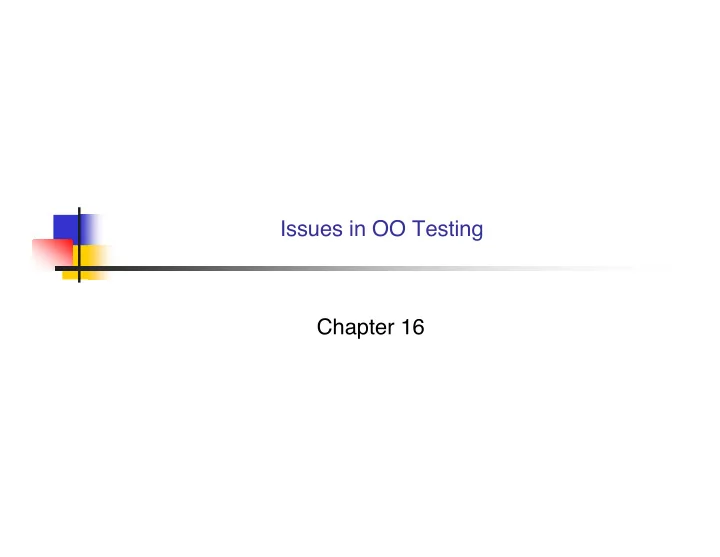

Issues in OO Testing Chapter 16
OO context OO based on hope that objects could be reused without Modification Additional testing Based on notion that objects encapsulate functions and data that belong together Consensus now is that such optimism is unwarranted OO programs has more severe testing problems than traditional programs ISS–2
OO context – 2 Looking to other models that can be combined with OO to ameliorate the problems Aspect-oriented programs Aspect-orientation can be combined with any programming language ISS–3
Problems to address Levels of testing What is a unit? Implications of composition strategy of OO Compare to functional decomposition OO programs Inheritance, encapsulation and polymorphism How can traditional testing be extended? ISS–4
OO unit Two definitions A unit is the smallest program component that can be compiled and executed A unit is a program component that would be developed by one person Could be a sub-part of one class ISS–5
Unit is 1-person development Traditional testing works well Shifts much of the burden of testing to the integration level Does not take encapsulation into account Know about themselves Operate on their own ISS–6
Unit is compilable & executable Can describe behaviour Model with FSM – Statechart Very useful for identifying test cases Integration testing is easy Integrate by combining already tested classes Similar to traditional testing ISS–7
Composition & Encapsulation A class may be combined with other unknown classes Goal of reuse Need high cohesion, low coupling Need very good unit testing Reality is that burden of testing is still on integration testing ISS–8
SWW– SSD 1 System Specification Diagram All communication channels are data stream Low coupling Channel P is a rough merge of the between Wiper data streams from Lever and Dial Lever and Dial ISS–9
SWW– SSD 2 Channel DL is a High coupling statevector read between Lever and Dial of Dial by Lever When does Lever read DL? ISS–10
SWW – SSD 3 High coupling between When does Wiper read Wiper and Lever LW and DW? Wiper and Dial ISS–11
Complication of inheritance Unit is more difficult to define when inheritance is involved Suggestion is to use the flat definition Becomes complicated with multiple inheritance Flattening solves inheritance problem Flattened classes are not a part of the system Cannot be certain they are properly tested ISS–12
Complication of inheritance – 2 See Figures 16.2 & 16.3 May not have necessary methods for testing Can add test methods Should they be a part of the delivered system? Analogous to having instrumented program text Test methods need to be tested !!! … ISS–13
Complication of polymorphism Testing with different objects Redundant tests on inherited methods Lose hoped for economies ISS–14
Levels of testing – Methods are units Four levels Method Unit testing Class Intraclass integration testing Integration Interclass integration testing System At port level – same as traditional testing ISS–15
Levels of testing – Classes are units Three levels Class Unit testing Integration Interclass testing System At port level ISS–16
Dataflow testing Need analogue to dataflow testing of units in traditional programs Use a revised Petri net definition to handle method calls between classes See Chapter 18, OO-integration testing ISS–17
Recommend
More recommend